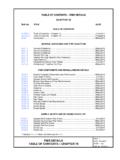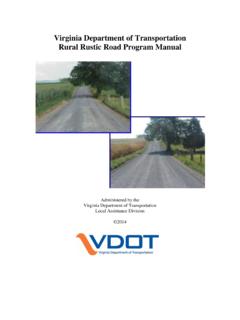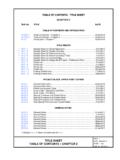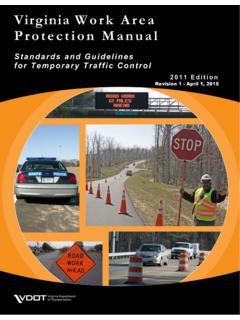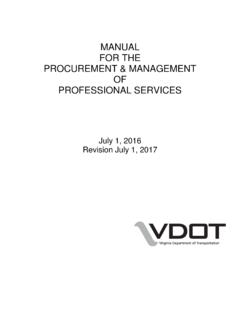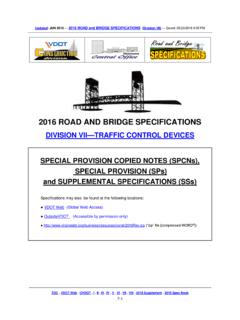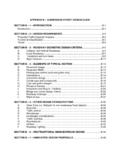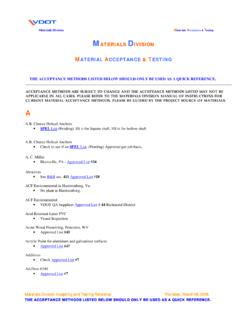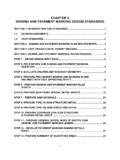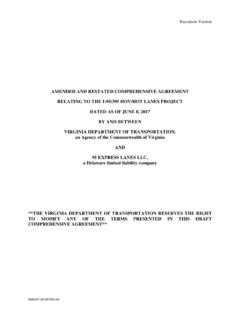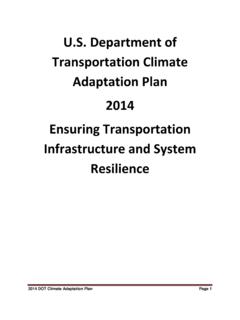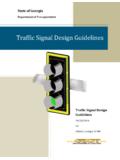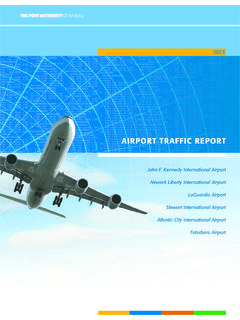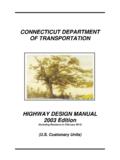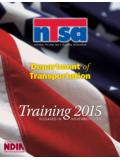Transcription of Virginia Department Highway Traffic Noise Impact …
1 Virginia Department of transportation Highway Traffic Noise Impact analysis guidance Manual FHWA Approval: March 15, 2011 CTB Approval: June 15, 2011 Effective: July 13, 2011 Updated: July, 14, 2015 (Version 7) Table of Contents i Purpose .. 1 Policy Statements .. 1 Federally-Funded Type I Highway Traffic Noise 1 Federally-Funded Type II Highway Traffic Noise Projects .. 2 Federally Funded Type III Highway Traffic Noise Projects .. 3 Qualifications Necessary to Perform Noise analysis .. 3 Time-Related Factors and Their Effects on Noise Studies .. 3 Effects of Revisions to Noise guidance .. 4 Using Different Traffic Noise Models and Versions .. 4 Using Different Versions of the FHWA Noise Model .. 4 Questions Regarding This Manual .. 5 Noise analysis Procedures .. 5 Scoping .. 5 Narrative analysis .. 6 Screening 7 Consideration of Areas Sensitive to Traffic Noise .
2 7 Common Noise Environment (CNE) Determination .. 7 Undeveloped and Developing Lands: Permitted .. 8 Determination of Existing Conditions .. 9 Selecting Receptor Sites for Monitoring and Modeling .. 9 Worst Noise Hour .. 10 Existing Noise Level 11 Monitor Similar and Unique 11 Existing Noise Barriers and Privacy Fences .. 11 In-Kind Barrier Replacement .. 12 Noise Modeling (Prediction of Existing and Future Conditions) .. 13 FHWA Model .. 13 Limitations .. 13 Traffic Speed 14 Model Validation Purpose .. 14 Model Validation Procedure .. 14 Determining Existing Worst Noise Hour(s) .. 16 Future No-Build Conditions .. 17 Future Build Conditions .. 17 Determining Highway Traffic Noise Impacts and Establishing Abatement Requirements ..18 Criteria for Detailed Highway Traffic Noise Abatement Measures .. 18 Table of Contents ii Highway Traffic Noise Abatement 18 Noise Abatement 20 Phase 1 Warranted Criterion.
3 20 Land Use Activity Category A .. 21 Land Use Activity Category B .. 22 Land Use Activity Category C .. 23 Land Use Activity Category D (Interior) .. 23 Land Use Activity Category E .. 24 Land Use Activity Category F .. 24 Land Use Activity Category G .. 24 Phase 2 Feasibility Criteria for Noise Barriers .. 25 Phase 3 Reasonableness Criteria for Noise Barriers .. 25 Viewpoints of the benefited receptors.. 26 Cost-effectiveness .. 26 Noise Reduction Design Goals .. 27 Category C Land Use Activity Areas .. 28 Completing the Warranted, Feasible, and Reasonable Worksheets ..29 Highway Traffic Noise Barrier Design: Commitments ..29 Highway Traffic Noise Barrier Goals (Barrier Optimization) .. 29 Highway Traffic Noise Abatement Commitments .. 30 Abatement Measure Reporting .. 31 Additional Considerations for Final Design Highway Traffic Noise Barrier analysis .
4 31 Final Design Considerations and Measures .. 31 Date of Public Knowledge .. 33 Desires of Those Individuals Impacted by Highway Traffic Noise .. 33 Applications for Absorptive Noise Barriers .. 33 Design-Build Projects .. 34 Construction Noise Consideration ..34 Public, Locality, and Agency Involvement ..35 Degree and Type of Involvement .. 35 Local Officials .. 36 Affected Receptors/Community .. 36 Voting Procedures .. 37 Voting on the Construction of the Noise Barrier .. 37 Aesthetics .. 39 Third-Party Funding Options .. 39 Table of Contents iii Reporting Results of Highway Traffic Noise Analyses ..40 Environmental Clearance Reporting .. 40 NEPA Reevaluations .. 40 Highway Traffic Noise analysis Project File .. 41 Section 106 Evaluations .. 42 Section 4(f) Evaluations .. 42 Title VI and Environmental Justice .. 44 Highway Traffic Noise Report: Format, Content, and Processing.
5 44 Highway Traffic Noise Report Format and 44 Highway Traffic Noise Report Processing .. 47 Extenuating Circumstances .. 47 Appendix A Definitions and guidance on Terms ..48 Appendix B Frequently Asked Questions ..54 Appendix C Title 23 Code of Federal Regulations, Part 772 ..58 Appendix D State Noise Abatement Policy ..70 Appendix E Activity Category C and D Calculation ..71 Appendix F Warranted, Feasible, and Reasonable Worksheet ..73 Appendix G Chief Engineer Concurrence Memorandums ..75 Appendix H Single Impacted Receptor Methodology ..82 Highway Traffic Noise Manual 1 Updated: March 31, 2014 Purpose This Manual provides procedures and guidance regarding Highway Traffic Noise Impact assessment and analysis for federal or federally-funded Type I Highway Traffic Noise projects during the Environmental Clearance and Final Design Phases in accordance with the National Environmental Policy Act (NEPA) of 1969.
6 Highway Traffic Noise Impact analysis , abatement procedures, criteria, coordination requirements, and reporting guidance contained herein are based on Title 23 of the Code of Federal Regulations, Part 772, the Federal Highway Administration s (FHWA) Procedures for Abatement of Highway Traffic Noise and Construction Noise , (23 CFR 772), which is included as Appendix C of this document. All transportation improvement projects developed in accordance with the Virginia Department of transportation s (VDOT) guidelines shall conform to the mandates and guidance of FHWA. FHWA regulations and guidance require that mitigation be considered whenever Noise impacts are identified. Note: Although the guidance in this Manual may cite a specific criterion or measure, requirements herein may be further modified for a specific project through the application of available industry wide practices and procedures.
7 As such, any specific criterion or measure cited in this Manual shall not be viewed as a restriction on VDOT's authority to require further analysis beyond a stated minimum standard. Policy Statements Federally-Funded Type I Highway Traffic Noise Projects It is VDOT s policy to assess the Highway Traffic Noise impacts of transportation improvement projects and, when potential Noise impacts are identified, to give consideration to the incorporation of appropriate avoidance and/or mitigation measures into the design and construction of federal or federally-funded Type I transportation improvement projects. Before Noise abatement measures can be considered, the appropriate level of Highway Traffic Noise analysis must be completed to adequately address whether Noise abatement measures are warranted, feasible, and reasonable.
8 This assessment is required to justify recommendations to construct any Highway Traffic Noise mitigation measures. Proposed transportation improvement projects that may be considered Type I Highway Traffic Noise projects include the following: (1) The construction of a Highway on new location; or, (2) The physical alteration of an existing Highway where there is either: (i) Substantial Horizontal Alteration. A project that halves the distance between the Traffic Noise source and the closest receptor between the existing condition to the future build condition; or, (ii) Substantial Vertical Alteration. A project that removes shielding therefore exposing the line-of-sight between the receptor and the Traffic Noise source. This is done by either altering the vertical alignment of the Highway Traffic Noise Manual 2 Updated: March 31, 2014 Highway or by altering the topography between the Highway Traffic Noise source and the receptor; or, (3) The addition of a through- Traffic lane(s).
9 This includes the addition of a through- Traffic lane that functions as a HOV lane, High-Occupancy Toll (HOT) lane, bus lane, or truck climbing lane; or, (4) The addition of an auxiliary lane, except for when the auxiliary lane is a turn lane; or, (5) The addition or relocation of interchange lanes or ramps added to a quadrant to complete an existing partial interchange; or, (6) Restriping existing pavement for the purpose of adding a through- Traffic lane or an auxiliary lane; or, (7) The addition of a new or substantial alteration of a weigh station, rest stop, ride-share lot or toll plaza. (8) If a project is determined to be a Type I project under this definition then the entire project area as defined in the environmental document is a Type I project. Note The FHWA Noise guidance recommends that State Highway agencies take a broad approach to defining auxiliary lanes with respect to Type I projects as defined in paragraph (4) of the definition of Type 1 project in 23 CFR Although the function of an auxiliary lane differs depending on the type of facility, an auxiliary lane should classify the project as Type I if the auxiliary lane is 2,500 feet or longer (see the AASHTO Policy on Highway Design or Green Book and Institute of transportation Engineers (ITE) Manual "Freeway and Interchange Geometric Design Handbook" for more information).
10 Note If a Type I project impacts to only one side of a Highway facility, the Noise analysis shall address both sides of the facility. Note If a project involves a combination of Type I improvements and non-Type I improvements, the entire project is treated as a Type I project. Note Federally-funded Type I projects shall be analyzed for Highway Traffic Noise in accordance with the guidelines in this Manual. Where the determination of a Type I project is unclear, consult the VDOT Central Office Noise Abatement Section. Note for weigh stations, rest stops, ride-share lots, or toll plazas contact Central Office Noise Abatement Staff for analysis methodology. Federally-Funded Type II Highway Traffic Noise Projects Type II projects are proposed federal-aid projects for Highway Traffic Noise abatement (construction of Noise barriers) on an existing Highway .
